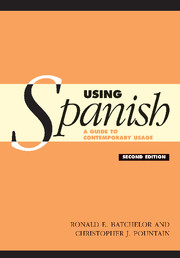Book contents
- Frontmatter
- Contents
- Authors' acknowledgements
- Preface to the second edition
- List of abbreviations and symbols
- Glossary
- The Spanish speaking world: countries where Spanish is spoken, with an estimate of the numbers of native speakers
- 1 Introduction
- 2 Passages illustrating register and local variety
- Part I Vocabulary
- Part II Grammar
- 21 Gender
- 22 Number
- 23 Word order
- 24 Prepositions
- 25 Prepositional constructions with verbs, nouns and adjectives
- 26 Constructions with verbs of movement
- 27 Negation
- 28 Use of tenses
- 29 Periphrastic verb forms
- 30 Modal auxiliaries
- 31 The Subjunctive
- 32 ser and estar
- 33 Personal pronouns
- 34 The reflexive
- 35 Comparison
- 36 Usage with names of countries
- Index
31 - The Subjunctive
Published online by Cambridge University Press: 05 June 2012
- Frontmatter
- Contents
- Authors' acknowledgements
- Preface to the second edition
- List of abbreviations and symbols
- Glossary
- The Spanish speaking world: countries where Spanish is spoken, with an estimate of the numbers of native speakers
- 1 Introduction
- 2 Passages illustrating register and local variety
- Part I Vocabulary
- Part II Grammar
- 21 Gender
- 22 Number
- 23 Word order
- 24 Prepositions
- 25 Prepositional constructions with verbs, nouns and adjectives
- 26 Constructions with verbs of movement
- 27 Negation
- 28 Use of tenses
- 29 Periphrastic verb forms
- 30 Modal auxiliaries
- 31 The Subjunctive
- 32 ser and estar
- 33 Personal pronouns
- 34 The reflexive
- 35 Comparison
- 36 Usage with names of countries
- Index
Summary
It should be stressed that in the Spanish of all registers and regions all the tenses of the Subjunctive are actively used today. In the Imperfect and Pluperfect Subjunctive, the -ra form is commoner than the -se form, especially in R1, and particularly in R1 Am. However, there are alternatives to many Subjunctive constructions which tend to be preferred in R1–2.
There are various uses of the Subjunctive, and it is essential not to think of the Subjunctive itself as having one characteristic ‘meaning’. Having said that, it is helpful to bear in mind that the Subjunctive is largely confined to subordinate clauses and is strongly associated with many contexts in which the speaker is not committed to the truth of that clause, and so it is used to express doubt, hypothesis, lack of agreement, emotional attitude, etc. It is also helpful to realize at the outset that in Spanish there are both contexts in which the Subjunctive is obligatory (in the same way that a plural adjective is obligatory with a plural noun) and contexts in which there is a choice between Subjunctive and Indicative. In the former case, the Subjunctive itself is automatically required and so has no distinctive meaning; in the latter case, there is usually a difference in meaning between Subjunctive and Indicative, and English speakers sometimes find this difficult to grasp.
- Type
- Chapter
- Information
- Using SpanishA Guide to Contemporary Usage, pp. 389 - 414Publisher: Cambridge University PressPrint publication year: 2005



